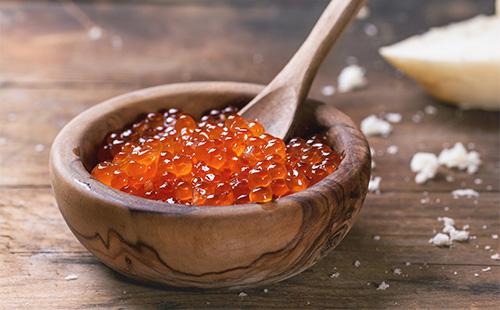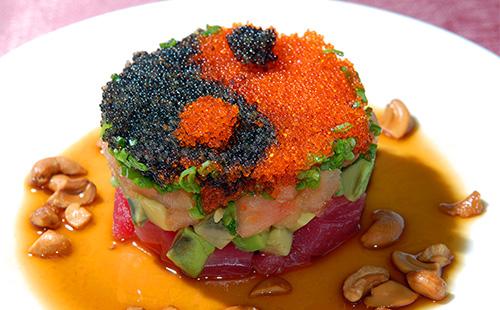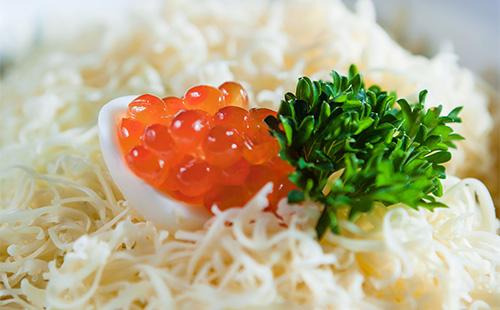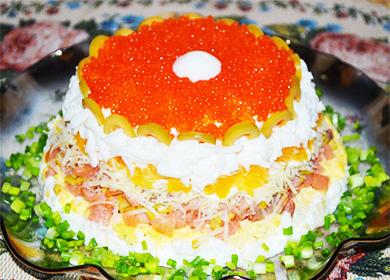Seafood salads have always been considered culinary delights and "elite" dishes - decoration of the festive table. But prices for quality seafood bite, and their inept choice can ruin the whole impression of the salad. As for the "Pearls", the ingenious housewives came up with a lot of variation of the salad, adding new components and replacing expensive products with more affordable ones. Now there is an opportunity to choose a recipe for your wallet and taste preferences.
How to choose seafood
The taste of the salad will depend on the quality of the products used. In the case of seafood, a responsible approach to selection also reduces the risk of poisoning - these are perishable products, their improper storage and transportation can be fraught with unpleasant consequences. In the recipes "Pearls" you may find:
- red fish;
- squid;
- Shrimp
- octopuses;
- mussels.
Red fish
The classic salad recipe features salted salmon. It can be replaced with trout. But be sure - in a slightly salted form. Salmon fish are expensive, so be careful at the counter so as not to spoil the salad and not waste money. What you need to pay attention to.
- Colour. It should be pale pink. Dark color - old fish. Too bright - the raw material was frozen or the fish was grown in artificial conditions using growth stimulants. Too bright color - dye is present.
- Veins. They should be crisp and white. If the veins are poorly distinguishable - the fish is stale or painted. If the veins are yellow - the fish is old.
- Salt. It is necessary to add slightly salted fish to the "Pearl" - the only way to achieve a balanced taste. The percentage of salt is indicated on the package - according to the standard it is 4-8%.
- The shape of the pieces. Not the most delicious result is obtained from the tail of the carcass - there is less fat and more bones. In addition, the tail absorbs more salt and there is a risk of buying salted fish. It is not difficult to find out such pieces - they have a characteristic “tail” shape, that is, they taper to one end. The meat is lean and more sinewy.
- Composition. Ideal - only salmon and salt. It is allowed to use a preservative (E211 - sodium benzoate) in a small amount, but it is better if it is natural, for example, rosemary.
- Elasticity. Press on a piece of fish - the fibers should quickly take their original shape. If this does not happen - the fish balls are stale or frozen raw materials were used.
- Liquid. It should not be inside the package. Absolutely. If meat secretes liquid, production processes have been disrupted. Leave such a piece in the store.
- Air. Air bubbles inside the vacuum packaging are not permitted. Upon contact with oxygen, decay processes begin.
- Release form. Salmon is sold in the form of steaks, fillets and thin slices. The cheapest option is steaks, but you will have to tinker with cutting fish and extracting bones. The plates, of course, are convenient - unpacked and ready. But unscrupulous manufacturers often shift whole pieces with damaged ones made from waste. The best choice is fillet.
Squid
There are chilled or frozen squids in the store in three versions: whole carcasses, fillets or sliced rings. They can be sold peeled and not. What to look for at the counter.
- Meat color. It should be white. Cream shade is allowed. The darker the meat, the older the squid was and the tougher its meat.
- Leather. This is an indicator of proper storage and transportation of squid. If it is damaged - do not buy. Most likely, the raw materials were frozen and thawed several times. That is why it is better to choose uncleaned carcasses.
- Ice. For a properly frozen product, the ice layer should not be thick, and the ice crust can easily be separated from the meat without damaging the fibers.
- Elasticity. The freshness of any meat is determined standardly - push the carcass - if the dent is restored within a few seconds, then the meat is fresh. If the tissues recover poorly - the carcass is already very old.
- Carcass size. The usual sizes are 20-35 cm. It’s better to buy these. The size depends on the origin and it is believed that the smaller the squid, the tastier the meat.
- Cutting. Remember: good squids are not cut. Peruvian squids are allowed on the fillet - in nature their size reaches two meters. Their meat is coarse, fibrous, with a pronounced ammonia flavor. In frozen form, they are sent to China for further processing. We are not talking about exquisite taste. It’s better not to buy squid sliced in rings. So cut the waste from the processing of large carcasses.
Shrimp
Shrimp can be sold fresh (a very rare option for places remote from the seas), fresh-frozen and boiled-frozen. In shell and without. Gourmets say that after the freshest, the most delicious are freshly frozen shrimps in shell. Outsiders - boiled and frozen peeled. And here is a list of equally important nuances.
- Tail. It should be tightened. The “unfolded” tail indicates that the shrimp was frozen already dead. And what death she died is unknown to us, and she will not answer.
- Shell color. In a good shrimp, the shell is uniformly pink. Stains and dark spots are a sign of “respectable age” and improper storage.
- Head color. Green - you can eat. Just shrimp fed on a certain type of plankton. Brown is perfect. So, the shrimp is pregnant and it is doubly useful to eat it. But the black head is a bad sign. Such a shrimp was sick, and it is by no means impossible to eat it.
- Caliber. In one package, all shrimp should be approximately the same size. If this is not so, the manufacturer is trying to sell cheap low-quality raw materials interspersed with good ones.
- Ice. It should not be inside the package. Chunks of ice and snow indicate that the shrimp, while driving to the counter, thawed and were re-frozen. And maybe more than once.
Octopus
It is known that octopuses can be poisonous. But it is impossible to meet this in stores.But you will have to be vigilant when buying, otherwise, like any seafood, it can be stale, which will lead to poisoning. Pay attention to the following points.
- Eyes. They must be clean and transparent. Like fish, a cloudy look says that the product is "not the first freshness."
- Leather. It should be clean, moist, resilient and intact. Dark spots at the ends of the tentacles are a sign of damage.
- Elasticity. Of course, fresh tissue will quickly restore shape after being pressed.
- The size. It is better to choose small specimens - this means that the octopus is young and it has tender juicy meat. Less likely to weld a rubber sole out of it.
- Ice. There should be no snow and ice inside the package. If they are, the seafood was re-frozen.
Mussels
Those who live near the sea have the opportunity to buy fresh “live” mussels. There will be no problems with the choice: they should smell fresh of the sea, the shells are tightly closed, clean and shiny. And they “shrink” if you knock on them. If in stores I sell only frozen mussels, then here's what you pay attention to when buying.
- Sink. A good mussel has a dark, glossy, "tightly" closed. A slightly open sink is a sign of a stale product.
- Ice. If there are pieces of ice and snow in the package or if the mussels freeze into a lump, they were stored incorrectly. Better not take the risk.
- The size. Irrelevant. The taste of meat does not depend on the size of the shell.
- Meat. It can only be white. A light pink color is allowed.
Pearl salad recipe: from exotic to economy option
What you will not find in the Pearl salad recipes: salmon, squid, shrimp, crab sticks, eggs, vegetables, oranges, rice, olives. These products may not be compatible with each other. But each recipe is verified, and the proportions are just such that the taste of the salad is as balanced and gentle as possible, none of the products “overwhelms” the rest. But the highest quality is still the quality of the products. One “miss” can reduce all efforts to nothing.
Classic: with salmon and orange
Features. Salad "Pearl" with salmon and orange is already considered a classic. Although more recently, this mysterious combination was intriguing and alarming. Do not worry, guests will not spit out the “novelty” - they will surely enjoy the fresh unbroken taste.
Products:
- slightly salted salmon (or trout) - 150-200 g;
- an orange - one fruit (or an equivalent volume of grapefruit pulp);
- black olives - 40 g;
- eggs - four pieces;
- hard cheese - 50 g (taste should be neutral);
- mayonnaise - to lubricate the layers;
- red caviar - for decoration;
- green onions or dill - for decoration;
- salt, pepper - to taste.
How to cook
- Boil the eggs, cool and peel the eggs.
- Leave one egg whole.
- Divide the rest into proteins and yolks.
- Grate proteins and yolks on a medium grater in different containers and mix with a small amount of mayonnaise - this way the layers will not fall apart and it will be easier to collect the salad. Pepper and salt a little.
- Cut the salmon into small cubes.
- Olives - in small circles.
- Remove the zest from the orange, peel the slices and chop the flesh.
- Make slices of salmon and orange about the same size.
- Grate cheese on a medium grater.
Layer sequence
- Half a mixture of protein and mayonnaise.
- Whole yolk-mayonnaise mass.
- Half the volume of salmon.
- Mesh of mayonnaise. It is important here not to “overdo it”.
- Sliced olives (leave a little for decoration).
- Mayonnaise.
- The second half of the salmon.
- Mayonnaise.
- Cheese.
- Mayonnaise.
- Orange.
- The second half of the proteins.
- Put caviar on top with a thin layer.
- To “drown” the whole boiled egg with the sharp end down - this will be the “pearl".
- In a circle, decorate with the remaining rings of olives and greens.
Sea Pearl: with squid
Features. And you can cook the Pearl salad in a different way - with squid. But it is important not to digest them, otherwise they will turn into a rubber-like rag.
Products:
- squid - 0.5 kg;
- crab sticks - 250 g;
- eggs - four pieces;
- red caviar - 100 g;
- mayonnaise, salt, pepper - to taste.
How to cook
- Boil eggs, cool, divide into yolks and squirrels.
- Leave one whole - it will go to decorate the dish.
- We need only proteins. Rub them on a medium grater.
- Dice crab sticks.
- Dip squids in boiling water.
- Cook for three minutes.
- Drain and cool.
- Cut into thin strips.
- All mix.
- Salt and pepper.
- Season with mayonnaise. Just a little bit, just to "combine" all the ingredients.
- Top with a thin layer of caviar.
- A “drowned” egg will act as a pearl.
"Black Pearl": with prunes
Features. Here is another option, how interesting it is to make a Pearl salad: with prunes and walnuts. Here, the role of the black pearl will be played by prunes with a “surprise”.
Products:
- crab sticks - 200 g;
- eggs - four pieces;
- prunes - 150 g;
- hard cheese - 300 g;
- walnut kernels - 100 g;
- mayonnaise - to lubricate the layers;
- butter - 50 g;
- salt and pepper to taste.
How to cook
- Send butter to the freezer.
- Boil the eggs.
- Wash the prunes and pour boiling water for a quarter of an hour.
- Now each prune needs to be stuffed with a suitable-sized nut kernel.
- Remove the oil and grate on a medium sized grater.
- Put it in the freezer again.
- Grate crab sticks and cheese on a medium grater in different dishes.
- Cut the eggs into small cubes or grate them too.
Layer sequence
- Half the eggs.
- Mayonnaise net.
- A quarter of the volume of crab sticks.
- Salt pepper.
- Half the volume of cheese.
- Half the volume of grated butter.
- All stuffed prunes. Leave one piece for decoration.
- The remaining three quarters of crab sticks.
- Salt pepper.
- Mayonnaise net.
- The second half of the cheese.
- The remaining oil.
- The eggs.
- Lubricate the top with a thin layer of mayonnaise so that the color of the salad turns evenly white.
- In the middle, put the "black pearl" - prune with a "surprise".

"Red Pearl": with cherry tomatoes
Features. The red "pearl" here is, of course, cherry tomato. Here is a more familiar flavor combination: crab sticks, cheese, garlic, tomatoes, but with an original serving.
Products:
- surimi sticks (imitation of crab) - 200 g;
- cherry tomatoes - ten pieces;
- hard cheese - 150 g;
- garlic - three to four cloves;
- mayonnaise - to taste;
- salt and pepper to taste.
How to cook
- Dice crab sticks.
- Grate the cheese.
- Dice tomatoes, but leave one to create a pearl.
- Pass the garlic through the garlic and mix with mayonnaise.
- Mix all the ingredients.
- Lubricate the salad with a thin layer of mayonnaise.
- Put in the center of the "red pearl" - cherry tomato.
To make the salad easier, add arugula or any other type of salad to it, decorate along the perimeter with sprigs of dill, and replace the mayonnaise with low-fat sour cream or homemade yogurt.
With vegetables
Features. This is the easiest salad option.And the “Pearl of the Sea” is very colorful, and the cucumber in the composition gives freshness.
Products:
- squid - 500 g;
- shrimp - 500 g;
- fresh cucumber - one (large);
- sweet pepper - one (yellow);
- pine nuts - one handful;
- grated cheese - one tablespoon;
- mayonnaise - for dressing;
- salt to taste.
How to cook
- Boil seafood.
- Cut squids into thin strips.
- Remove the shells and intestinal vein from the shrimp.
- Cut cucumbers and peppers into strips.
- All mix.
- Pour a handful of pine nuts.
- Salt.
- Season with mayonnaise.
With shrimps
Features. And here is another good Pearl salad - with shrimp and red caviar. There is a “loading dose” of protein due to two “marine” components at once. And if you use low-calorie mayonnaise, it will perfectly fit into the proper nutrition menu.
Products:
- squid - 0.5 kg (canned can be used);
- shrimp - 300 g;
- eggs - four pieces;
- quail egg - one (for decoration);
- mayonnaise - to lubricate the layers;
- red caviar - 100 g (for decoration);
- salt to taste.
How to cook
- Submerge the shrimp in boiling salted water.
- After boiling again, cook another three to four minutes.
- Cool and remove the shells. Be sure to separate the intestinal vein.
- Boil squids (if they are not canned).
- Cut them into thin strips.
- Cook the eggs, cool.
- Divide into yolks and squirrels and grind into different plates.
- Combine the whites and yolks with a little mayonnaise. Pepper and salt.
Layer sequence
- Squid.
- The entire volume of the mixture of yolk and mayonnaise.
- Half a shrimp.
- The whole protein-mayonnaise mixture.
- Spread red caviar evenly.
- Lay the "pearl" - a quail egg.
- Along the perimeter, beautifully lay out the remaining shrimp.

"Mediterranean Pearl": with mussels and octopus
Features. This is probably the most exotic and expensive salad recipe. For the “Mediterranean Pearl” you will have to buy mussels, shrimp and octopus meat.
Products:
- shrimp - 0.5 kg peeled;
- octopus meat - 0.5 kg;
- mussels - 0.5 kg peeled;
- any kind of green salad - one package;
- sweet pepper (large) - one each of red and green;
- olive oil - for dressing;
- lemon - one fruit;
- salt - one pinch.
How to cook
- Boil the octopus. For this, the meat is dipped in boiling water. Large carcasses cook for an hour with the lid closed on a slow fire. The average size of the octopus should be cooked for 20-30 minutes. Small carcasses and tentacles - five to ten minutes.
- Cook the mussels. Fold the sinks in a saucepan and fill with a little water to completely cover the sinks. Squeeze the juice of half a lemon there. Turn on the fire to maximum and close the lid. After the water boils and the shells open slightly, cook for another three minutes over high heat. Do not open the cover.
- Boil shrimp too and remove the shells.
- Remove the mussels from the shells.
- Cut the octopus into rings.
- The pieces of all seafood should be about the same size.
- Red and green peppers cut into a cube.
- Put all the ingredients in a large salad bowl.
- Salt.
- Squeeze the juice from the second half of the lemon.
- Season generously with olive oil.
- Shuffle.
- Put the marinated salad in the fridge overnight. At least four hours.
- Before serving, pick the lettuce and mix again.
The budget version with canned goods
Features. And this is the most budget option "Pearls in the grass." It can be cooked even without much reason - it will decorate any table.
Products:
- canned sardines - one can;
- dry rice - 50 g;
- eggs - four pieces;
- dill greens - one bunch;
- mayonnaise - to lubricate the layers;
- salt and pepper to taste.
How to cook
- Rinse and boil the rice.
- Slice the dill.
- Boil the eggs.
- Grind yolks and proteins in separate containers.
Layer sequence
- Mash sardines with a fork at the bottom of the salad bowl.
- Mesh of mayonnaise.
- Layer of rice. Leave the volume of a tablespoon for decoration.
- Salt and pepper.
- Mayonnaise net.
- A layer of dill.
- The yolks.
- Mayonnaise.
- Squirrels.
- Thin layer of mayonnaise.
- Sprinkle generously with dill on top. It will be "grass."
- In the remaining rice, add a little mayonnaise and roll the ball.
- Put the rice "pearl" in the middle of the "field".

Unusual serving methods
It is the name of this salad that calls us to arrange it in the form of a shell. Recipes that do not imply layering can be served in batches. And here are three ideas on how to make “edible” and unusual shells.
- From apple. Peel and cut the apple into two. Remove the core and part of the pulp so that the half looks like a shell flap. In one “leaf” put a serving of salad. And fix the second side with a toothpick. A little later, the apple is covered with a brown coating - just the right color for the sea shell.
- From cabbage. You need parts of leaves with thick veins (which are near the stump itself). Trim the edges of the leaves so that the rest looks like a shell flap. Color the cabbage with beetroot juice. In one of them you put a portion of salad, and fix the second sideways, closing the sink.
- From the test. It will take: one egg, a glass of water, a glass of flour, a pinch of sugar, sunflower oil. Mix water, flour, egg, sugar. Heat the oil in a narrow, deep container with a diameter slightly larger than a ladle. Dip the ladle into the batter to the brim and then into the hot oil. Browned - it's time to take out. Remove the dough from the ladle. Two such “hemispheres” will serve as folds.
And if you didn’t see the “same” composition in the recipes, come up with your own author’s recipe. Experiment with proportions, with combinations of tastes, decoration - find your perfect Sea Pearl salad and surprise your guests with your culinary imagination.

